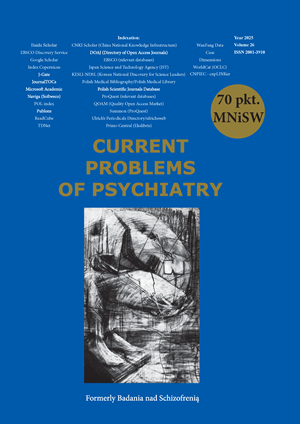Orthorexia in a population of Polish university students: prevalence aswell as demographic and psychological risk factors
DOI:
https://doi.org/10.12923/2353-8627/2025-0003Keywords:
orthorexia, orthorexia nervosa, eating disorders, obsessive-compulsive disordersAbstract
Introduction: The number of publications on orthorexia is steadily increasing, however little is still known about the psychological risk factors. The purpose of this study was to determine the prevalence of the risk of orthorexia in a population of students doing various university courses, and to estimate psychological risk factors for orthorexia in this group. The relationships between the risk of orthorexia and demographic factors were also analyzed.
Material and methods: The study was conducted on a group of 447 respondents (350 women, 97 men) aged 17-50 years (mean 22.34). The Polish version of the ORTO-15 scale with a threshold of 35 points was used to estimate the risk of orthorexia.
Results: The risk of orthorexia was identified in 22.6% of the total study group. Gender, the course of study, being in a relationship and body mass index were unrelated to the risk of orthorexia. However, such risk was higher in those from singleparent families and those who exercise more often. The risk of orthorexia was increased by attachment anxiety and overall risk of eating disorders, and decreased by the preference for a physically active lifestyle. Emotional intelligence and perceived social support were unrelated.
Conclusions: The risk of orthorexia is common in the population of Polish students, and is increased by a general tendency for eating disorders, insecurity in close relationships, and being raised in a single-parent family. Those at higher risk of orthorexia engage in physical activity more frequently, although they may derive less pleasure from it.
References
1. Lech M, Ostrowska L. Psychologiczne aspekty otyłości. Forum Zaburzeń Metabolicznych, 2017;8(2):63-70.
2. Dunn TM, Bratman S. On orthorexia nervosa: A review of the literature and proposed diagnostic criteria. Eat Behav. 2016;21:11-17. https://doi.org/10.1016/j.eatbeh.2015.12.006
3. Bratman S. Health food junkie: Obsession with dietary perfection can sometimes do more harm than good, says one who has been there. Yoga Journal, 1997;136:42-46.
4. Orthorexia [Internet]. National Eating Disorder Association [cited Dec 20, 2024]. Available from: https://www.nationaleatingdisorders.org/orthorexia/
5. Bratman S, Knight D. Health Food Junkies. Orthorexia nervosa: Overcoming the obsession with healthful eating. New York; Press: 2000. https://doi.org/10.1001/jama.285.17.2255-jbk0502-2-1
6. Depa J, Schweizer J, Bekers SK, Hilzendegen C, Stroebele-Brnschop N. Prevalence and predictors of orthorexia nervosa among German students using the 21-item-DOS. Eat Weight Disord. 2017;22(1):193-199. https://doi.org/10.1007/s40519-016-0334-0
7. World Health Organization. International Classification of Diseases Eleventh Revision (ICD-11). Geneva; Press: 2022.
8. American Psychiatric Association. Diagnostic and statistical manual of mental disorders (5th ed.). Washington; Press: 2013.
9. Almeida C, Vieira Borba V, Santos L. Orthorexia nervosa in a sample of Portuguese fitness participants. Eat Weight Disord. 2018;23(4):443-451. https://doi.org/10.1007/s40519-018-0517-y
10. Eriksson L, Baigi A, Marklund B, Lindgren EC. Social physique anxiety and sociocultural attitudes toward appearance impact on orthorexia test in fitness participants. Scand J Med Sci in Sports, 2008;18(3):389-394. https://doi.org/10.1111/j.1600-0838.2007.00723.x
11. Barnes MA, Caltabiano ML. The interrelationship between orthorexia nervosa, perfectionism, body image and attachment style. Eat Weight Disord. 2017;22:177-84. https://doi.org/10.1007/s40519-016-0280-x
12. Asil E, Sürücüoğlu MS. Orthorexia nervosa in Turkish dietitians. Ecol Food Nutr. 2015;54(4):303-313. https://doi.org/10.1080/03670244.2014.987920
13. Koven N, Senbonmatsu R. A neuropsychological evaluation of orthorexia nervosa. Open J Psychiatry, 2013;3:214-222. https://doi.org/10.4236/ojpsych.2013.32019
14. Koven N, Abry A. The clinical basis of orthorexia nervosa: Emerging perspectives. Neuropsychiatr Dis Treat. 2015;11:385-394. https://doi.org/10.2147/ndt.s61665
15. Scarff JR. Orthorexia nervosa: An obsession with healthy eating. Fed Pract. 2017;34:36-39.
16. Strahler J, Wachten H, Neuhofer S, Zimmermann P. Psychological correlates of excessive healthy and orthorexic eating: emotion regulation, attachment, and anxious-depressive-stress symptomatology. Front Nutr. 2022;9:817047. https://doi.org/10.3389/fnut.2022.817047
17. Oberle CD, Samaghabadi RO, Hughes EM. Orthorexia nervosa: Assessment and correlates with gender, BMI, and personality. Appetite, 2017;108:303-310. https://doi.org/10.1016/j.appet.2016.10.021
18. Gleaves DH, Graham EC, Ambwani S. (2013). Measuring “orthorexia:” Development of the eating habits questionnaire. Int J Educ Psych Assess. 2013;12(2):1-18.
19. Vuillier L, Robertson S, Greville-Harris M. Orthorexic tendencies are linked with difficulties with emotion identification and regulation. J Eat Disord. 2020;8:15. https://doi.org/10.1186/s40337-020-00291-7
20. Tiller JM, Sloane G, Schmidt U, Troop N, Power M, Treasure JL. Social support in patients with anorexia nervosa and bulimia nervosa. Int J Eat Disord. 1997;21(1):31-38.
21. Zhang J, Wang Y, Chenggang W, Jinbo H. The relationship between emotional intelligence and eating disorders or disordered eating behaviors: A meta-analysis. Pers Individ Dif. 2022;185:111239. https://doi.org/10.1016/j.paid.2021.111239
22. Stern M, Rubino L, Desjardins C, Stice E. Prospective reciprocal relations between social support and eating disorder symptoms. J Psychopathol Clin Sci. 2023;132(8):1043-1050. https://doi.org/10.1037/abn0000861
23. Stochel M, Janas-Kozik M, Zejda J, Hyrnik J, Jelonek I, Siwiec A. Walidacja kwestionariusza ORTO-15 w grupie młodzieży miejskiej w wieku 15-21 lat. Psychiatr Pol. 2015;49(1):119-34. https://doi.org/10.12740/pp/25962
24. Jaworowska A, Matczak A. PKIE - Popularny Kwestionariusz Inteligencji Emocjonalnej. Podręcznik. Warszawa; Press: 2005.
25. Lubiewska K, Głogowska K, Mickiewicz K, Wojtynkiewicz E, Izdeski P. Skala Experience in Close Relationships-Revised: Struktura, rzetelność oraz skrócona wersja skali w polskiej próbie. Psychologia Rozwojowa, 2016;21(1):49-63.
26. Brzybyła-Basista H, Buszman K. Polska adaptacja Wielowymiarowej Skali Spostrzeganego Wsparcia Społecznego. Polskie Forum Psychologiczne, 2017;22(4):581-599.
27. Rogoza R, Brytek-Matera A, Garner DM. Analysis of the EAT¬26 in a nonclinical sample. Arch. Psychiatry Psychother. 2016;18(2):54-58. https://doi.org/10.12740/app/63647
28. Głębocka A. Niezadowolenie z wyglądu a rozpaczliwa kontrola wagi. Kraków; Press: 2009.
29. Tremelling K, Sandon L, Vega GL, McAdams CJ. Orthorexia nervosa and eating disorder symptoms in registered dietitian nutritionists in the United States. J Acad Nutr Diet. 2017;117(10):1612-1617. https://doi.org/10.1016/j.jand.2017.05.001
30. Fernandes V, Rodrigues F, Jacinto M, Teixeira D, Cid L, Antunes R, et al. How does the level of physical activity influence eating behavior? A self-determination theory approach. Life (Basel), 2023;13(2):298. https://doi.org/10.3390/life13020298
31. Kamody RC, Lydecker JA. Parental feeding practices and children's disordered eating among single parents and co-parents. Int J Eat Disord. 2021;54(5):812-820. https://doi.org/10.1002/eat.23490
Downloads
Published
Issue
Section
License
Copyright (c) 2025 Authors

This work is licensed under a Creative Commons Attribution 4.0 International License.


